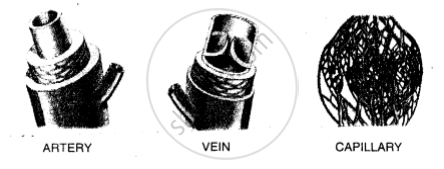Advertisements
Advertisements
प्रश्न
Name the three kinds of blood vessels found in human beings. With the help of suitable diagrams, differentiate between them.
उत्तर
The three kind of blood vessels found in human beings are arteries, veins and capillaries.
- Arteries are the blood vessels that carry blood from the heart to the various parts of the body.
- Veins are the blood vessels that carry blood from the body parts to the heart
- Capillaries: These are the terminal branches of an artery, which rejoin to form a vein. A capillary is a very narrow tube whose walls have a single layer of cells with no muscles. Although the wall of a capillary is very thin, yet an exchange of nutrients, waste products and gases take place between the blood and the body fluids.

Differences:
Arteries
- Carry blood away from the heart.
- Have thick and more muscular walls.
- Carry oxygenated blood (except pulmonary artery which carries deoxygenated blood).
- The blood flows with jerks and under great force.
Veins
- Carry blood towards the heart.
- Have thin and less muscular walls.
- Carry deoxygenated blood (except pulmonary vein which carries oxygenated blood).
- The blood flows smoothly and under little pressure
Capillaries
- Arteries after entering an organ divide into number of smaller branches called arterioles which further divide repeatedly to form a network of fine branches called capillaries.
- The walls of the capillaries are very thin and are one cell deep.
- The Capillaries after the metabolic exchange unite to form larger vessels called venules, which again unite to form a vein.
APPEARS IN
संबंधित प्रश्न
Describe the function of the heart.
The diagram below represents the simplified pathway of the circulation of blood. Study the same and answer the questions which follow:

(i) Name the blood vessels labelled 1 and 2.
(ii) State the function of blood vessels labelled 5 and 8.
(iii) What is the importance of the blood vessel labelled 6?
(iv) Which blood vessel will contain a high amount of glucose and amino acids after a meal?
(v) Draw a diagram of the different blood cells as seen in a smear of human blood.
Give reason, why a matured mammalian erythrocyte lacks nucleus and mitochondria?
Production of RBCs occurs in ______.
Find the odd one out.
Why does the left ventricle possess a thicker wall than the right ventricle?
Given below is the simplified pathway of the circulatory system:
(i) Name the blood vessels marked 1 to 8.
(ii) Name the chamber of the heart which:
(a) Receives blood from ‘1’.
(b) Pumps blood into blood vessel ‘8’.
(iii) Mention two structural differences between blood vessels ‘7’ and ‘2’.
Describe how the exchange of oxygen and carbon dioxide gases takes place in the lungs.
Which component of the haemoglobin molecule combines with the oxygen molecule to form oxyhaemoglobin?
